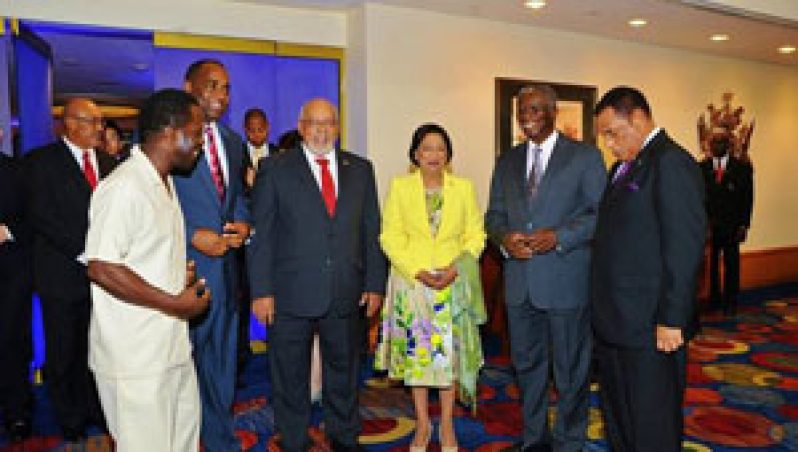WITH the conclusion last evening of the 34th annual Heads of Government Conference in Trinidad and Tobago, we can expect to officially learn today of new initiatives, if any, taken during the three days of meetings and activities focused on the future of CARICOM now in its 40th year of existence.
 Following Wednesday’s ceremonial opening, the leaders were engaged in a “commemoration” ceremony at Chaguaramas, designed to recall the historic signing — at the same venue — of the CARICOM Treaty by a quartet of then Prime Ministers (all since passed away) to make possible what largely now exists, with varying dimensions, as our economic integration movement.
Following Wednesday’s ceremonial opening, the leaders were engaged in a “commemoration” ceremony at Chaguaramas, designed to recall the historic signing — at the same venue — of the CARICOM Treaty by a quartet of then Prime Ministers (all since passed away) to make possible what largely now exists, with varying dimensions, as our economic integration movement.
On Friday, at their tightly guarded retreat at Point-a-Pierre (a famous central hub for the twin-island state’s vital energy sector), Heads of Government were locked in intensive discussion at which tough but necessary decisions were expected on too often postponed initiatives to achieve the primary objectives of the elusive single market and economy (CSME).
The end-of-conference communiqué should enlighten us if they succeeded in parting company with the old habit of deferring decisions on key issues, or settled for customary rationalizations for recurring failures to DO what they are so good at promising.
The end result of such rationalisations, as we have come to discover, is the sustaining of an implementation deficit on decisions unfulfilled. Consequently, the prevailing depressing detachment syndrome between the Community’s people and the regional political directorate.
In this year of CARICOM’s 40th anniversary, instead of the inspiring rhetoric and promises to deliver on the reality of “One Community for One People”, there is, instead, the debit side, as recalled by affected citizens across the region, of unchecked harassment, and worse, at ports of entry, including bizarre examples of humiliation.
CCJ and regional parliament
Further, there are recurring wars over intra-regional trade—even as leaders of the business sector and relevant cabinet ministers behave, at times, as if unaware of mechanisms in place to amicably resolve such disputes.
They would also know that, ultimately, there is a Caribbean Court of Justice (CCJ), armed with original jurisdiction to deal with such disputes. Sadly, since its inauguration in 2005, only three CARICOM states—Barbados, Guyana and Belize—have accessed the CCJ as their final appeal court.
Another useful post-colonial institution, though of less importance than the CCJ, the Assembly of Caribbean Community Parliamentarians (ACCP), had no more than three meetings, following its inauguration in May 1996, before it disappeared off the CARICOM radar.
A reminder of another downside for CARICOM at 40 came just last week on the eve of the Port-of-Spain summit when the current President of the Caribbean Congress of Labour (CCL), David Massiah, thought it necessary to make a public plea before a meeting of the region’s Ministers of Labour for “re-enagement”, as was the norm during an earlier dispensation.
CCL and CAIC
Perhaps the CCL President is unaware that the region’s private sector is faced with a similar sad tale of being ignored for structured “consultations” — as was also customary during much earlier Heads of Government Conferences — via an established tripartite consultative mechanism.
Of course, blame for CARICOM’s shortcomings rests not just with CARICOM governments—though they are, of necessity, the principal driving force. Most certainly to share some of the blame would be major private sector entities; two leading ones that come readily to mind would be the Caribbean Association of Industry and Commerce (CAIC) and, yes, the Caribbean Congress of Labour.
It would be most enlightening to learn of any NEW initiative of significance undertaken by these organizations within the past two years to encourage or inspire a mood-change for active ‘partnership’ cooperation with governments.
Have they even thought of being engaged with their respective local or regional constituencies, in any collaborative activity of relevance to mark the 40th anniversary of CARICOM?
Grievously, this columnist is unaware of any official public activity, in any member state, to mark the July 4 birthday four decades ago of CARICOM? It used to happen, even with a national holiday in a couple of countries, or more generally with official broadcasts of goodwill messages. Not so now.
But back to last week’s summit: Did either the CAIC or CCL consider it relevant to request consultations with the Heads of Government, while in Port-of-Spain, on matters of direct concerns in the interest of their respective constituencies?
Relatedly, how really focused at this time are the CAIC and CCL in the cause of regional economic integration and functional cooperation?
For now, amid the CARICOM “blues”, the Community’s citizens can only look forward, with hope, to some official “good news” from the communiqué on the 34th summit in Port-of-Spain, while facing the practical reality.
The harsh reality is: For all its evident weaknesses and the disappointments spawned, had there been no CARICOM in 2013, we may well have been compelled by the recurring challenging political, economic and financial global developments, to create one—perhaps by a different name.
For, warts and all, it’s difficult to contemplate a comparatively small regional economic integration movement of diverse nationalities, ethnicities, varying levels of socio-economic development going their separate ways.
At least the Founding Fathers of CARICOM came forward with a vision and a plan to motivate but the diverse nationalities, sharing so much in common needs and aspirations, in these islands and mainland territories that constitute our ‘Caribbean home’




.png)









